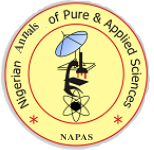Assessment of Heavy Metals in Water Contaminated with Petroleum Products in Keffi Local Government Area, Nasarawa State, Nigeria.
DOI:
Keywords:
Heavy Metals, Contaminated Water, Petroleum Products, KeffiAbstract
This work assessed the presence of heavy metals in water contaminated with petroleum products in Keffi Local Government Area. Two water sampling station were selected based on the stratified method of sampling of Antau River. Station A is located along Federal Government College Keffi popularly known as Antau Bridge where Agricultural and mechanical activities, with sales of petroleum product take place. Station B was located at Dadin Kowa known as Gada Manu where human activities such as bathing and washing takes place which served as control. The distance between stations is 1km. The procedural plan of this study was monthly sampling of water from both Stations. Materials such as funnel, sampling container, distilled water, conical flask, filter paper, 50ml polypropylene centrifuge tube, cooler were used. Heavy metal concentration was determined using X – ray Fluorescent Spectroscopy (XRF) at the Center for Energy Research and Training (CERT), Ahmadu Bello University Zaria. The water parameters of the four samples were determined using the Extech instrument. The result on Physico – chemical parameters revealed the values obtained from contaminated water samples to be pH (7.31), Dissolved Oxygen (1.14), Electrical Conductivity (8.22), Total Dissolved Solid (4.13), Temperature (27.45) and Salinity (0.091) while the controlled Station at point B were pH (7.43), DO (7.35), EC (3.14), TDS (1.54), Temperature (26.75), Salinity (0.o94) respectively. From the result obtained, the heavy metal contaminated samples had the following values: Mg (29.31±), Al (218.69±), Si (230.12±), S (1153.65±), Cl (54.25±), Ca (106.56±), Ti (23.66±), Cr (3.15±), Fe (15.92±), Cd (7.54±). For the control sample at point B, the following values were obtained: Mg (27.49±), Al (223.71±), Si (243.21±), S (94.84±), Cl (23.52±), Ca (28.44±), Ti (32.99±), Fe (16.63±), Cd (7.67±) respectively. The P-value was 0.8105 (p>0.05) for the water quality parameters while for the concentration of heavy metal P-value was 0.2054 (p>0.05). This implies that there was no significant difference between the concentrations of elements. However, the concentration values of heavy metals in the contaminated water at Station A and control water samples at Station B were higher than the World Health Organization values (Standard) for drinking water
Downloads
Published
How to Cite
Issue
Section
License
Copyright (c) 2020 JK Makpo, SM Ameh, A Asarya, YP Gambo

This work is licensed under a Creative Commons Attribution-ShareAlike 4.0 International License.



 Contact Us
Contact Us Editorial Team
Editorial Team Join As A Reviewer
Join As A Reviewer  Request For Print Copy
Request For Print Copy


 Cprint Publishers
Cprint Publishers